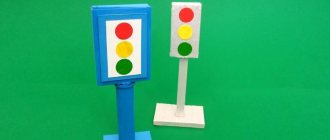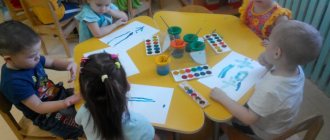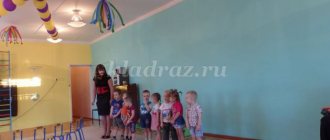Summary of a drawing lesson in the junior group “Little Man”
Lyudmila Nikolakhina
Summary of a drawing lesson in the junior group “Little Man”
State budgetary preschool educational institution kindergarten No. 47 for the cognitive and speech development of children in the Nevsky district of St. Petersburg.
Summary of the open event: the direct educational activities of the teacher with children of primary preschool age.
Topic: Drawing " Man "
Compiled and conducted
Teacher Nikolakhina L.B.
Summary of an open drawing lesson in the junior group of kindergarten : “ Little Man ”
.
Compiled by teacher of the highest category
Nikolakhina L.V. GBDOU No. 47
Goal: Teach children to draw a person .
1) Educational. -Teach children to draw a person with a pencil , conveying the characteristic features of appearance.
2) Developmental. - Develop the ability to hold a pencil correctly, perform simple actions with it: draw small circles (dots, circle-head oval ( “cucumber”
) - torso, stick-handles, legs.
-Develop fine motor skills of the hands, aesthetic taste, effort, desire to draw .
3) Educational. - To educate: accuracy, perseverance, interest in the result obtained.
-Evoke an emotional response, the desire to draw a boy or girl, using the hairstyle of the clothes for this purpose.
Pedestrians, cars, sidewalk, roadway.
Preparing two large sheets of paper (wallpaper)
with the image of the road, carriageway and pedestrian parts.
On the roadway there are figures of cars made of paper folded in half so that they can stand.
Colored pencils, sheets of A4 paper folded in half (for drawing )
.
Examination of a picture of a person , features of the appearance of boys and girls, a variety of clothes.
Didactic game “Find clothes for boys and girls”
.
Examination of illustrations on the topic of traffic rules.
“What do I know about myself?” Lesson on familiarization with social reality
Goal: to introduce children to the structure of the human body and the capabilities of the body;
to activate children’s attention to the skills and physical capabilities of their body; develop research activities; develop self-esteem. Progress of the lesson
— Guys, I want to read you the fairy tale “The Mole and the Man.” One day, a mole was digging a new underground passage and accidentally ended up in a garden where a man was working. A mole and a man met. The mole asks the man: “I have heard a lot about you, man, from various animals, worms and beetles. Everyone says that you are smart, strong, brave, hardworking and everything, then you are a person, you can do everything, but I want to know what kind of person you are. The man laughed and answered: “I don’t look like a worm, not like a bird, not like a beast, not like you, I look like myself.”
Children, let's tell the mole about ourselves, who we are? (People). Who are you Dima? Who are you Katya?
(Lead the children to the answers “I am a man,” I am a boy,” “I am a man, I am a girl”).
- Do you know why a person is the smartest, the bravest, the most hardworking? Because a person has many helpers. These helpers make our life easier and more convenient. Children, show and show what kind of helpers all people have, you have. The children name it and show it to themselves in the picture. (Eye, ears, nose, tongue, hands, feet).
Legs
- Guys, why do you need legs? (Walk, run, jump, dance, play football, stomp, stand on tiptoes). I suggest you stand up and perform actions with your feet.
Hands
- Why do we need hands? (Draw, play, take objects). The teacher imitates some action. (Sewing, washing, combing hair, mopping the floor, playing the violin and piano, hammering a nail, putting on a jacket) - the children guess.
Game: “Determine what it is” (identify objects by touch).
Game: “Who can put on the hat faster” (Pasha will put on the hat with two hands, and Danil with one hand). What do you guys think, why did Pasha put on his hat faster than Danil? To summarize: it is very important that we have two hands; it is easier to do work with two hands than with one.
Language.
- Guys, why do we need a tongue? (Talk, eat, determine the taste of food: salty, bitter, sour, sweet). Children, what is the mole whispering to me? All clear. He asks you to guess what he has for lunch.
I blindfold the children and let them try: onion, pickled cucumber, lemon, chocolate. Children try products.
- What kind of food does this taste like, how did you guess? Which assistant told you the correct answer?
Nose
- Children, why do we need a nose? (Breathe, catch odors). And our mole is going to visit, he will now wash himself, comb his fur, but the mole also wants to put on perfume, but does not know how it can smell. Help him.
Children blindfolded smell garlic - it could be perfume, maybe tell me what it is? Let me smell an orange, is that perfume? And then let me smell the perfume, what it is, you guessed it.
-Your nose is a very good assistant.
Ears
- Tell me, why do we need ears? (Hear people talking, birds singing, music playing, a brook babbling, thunder making noise). So the mole came to visit, and of course there will be music playing at the guests. You have to guess what instruments the musicians will play at the party.
Game "Identify by sound."
Eyes
- Guys, let's tell the mole why we need eyes (To see objects, people, distinguish colors, see stars, snow). Tell me, does the mole have good eyesight, but he only leads underground, but here he hardly leads. But the mole decided to play a game at a party. The game is called "Which toy disappeared." The mole asks for your help.
Summarizing.
“That’s how much I do for us with my hands, feet, ears, tongue, eyes. What are you doing for them? Our helpers must be protected from bruises and wounds. They need to be washed, cleaned, looked after, and then the assistants will help us for a very long time. Mole thanks you guys for telling us about yourself so interestingly. He will tell all his mole friends who the person is and what kind of assistants the person has.
Author: Galina Leondovna Kotikova, teacher of MBDOU “Kindergarten No. 41 “Ugolyok”, Mezhdurechensk city, Kemerovo region, Russia.
The article is published in the author's edition.
Preview:
"Parts of the body and face"
Class . There are such boys (Drawing with a simple pencil)
Program content. Teach children to draw a happy and sad face with a simple pencil. Learn to analyze and understand the content of a poem. Cultivate a friendly attitude towards others. Learn to express and describe your feelings.
Material. Landscape sheets, simple pencils (for each child).
Read excerpts from A. Barto’s poem “There are such boys” to the children:
We look at the boy - He’s kind of unsociable! He frowns and sulks, as if he drank vinegar. We thought and thought, We thought and came up with: We will be, like Vovochka, Gloomy, gloomy. We went out into the street - They also began to frown. He looked at our faces, He was about to get angry, Suddenly he burst out laughing. He doesn't want to, but he laughs louder than a bell.
Ask the children:
– What was the boy like at the beginning of the poem? (Gloomy, angry, sad.)
– What did he become at the end of the poem? (Cheerful, kind, laughing.)
Invite the children to portray first a sad boy, and then a cheerful one. To do this, you need to draw a circle on the left half of the sheet - a face, eyebrows in the form of downward arches and a mouth, with the corners of the lips downward. On the right side of the sheet you need to draw a circle - a face, straight eyebrows and a smiling mouth with the corners of the lips raised up.
At the end of the lesson, ask the children when they feel sad and when they feel happy.
Source
Abstract of the GCD for the second junior group “I am a man”
Alikova Samikha Khasanovna
Abstract of the GCD for the second junior group “I am a man”
Program objectives: To form children’s ideas about themselves as a person. Clarify and generalize knowledge about the structure of the human body, the functions of different parts of the body.
Reinforce the concept of “one - many”. Expand vocabulary: people, man, head, torso, legs, arms. Strengthen the skill of communicating with each other by name. Develop cultural behavior skills.
Preliminary work: Looking at illustrations, finger games, reading nursery rhymes.
Material: Pictures depicting a boy, girl, man, grandmother, hare, fox, bear, wolf. Doll Masha. Matryoshka. Opaque jars with garlic and lemon. Audio recording with bird voices.
Progress of the lesson.
Educator: Guys, look who came to us. This is our familiar doll Masha. Hello, Masha!
Progress of activities:
- Hello guys! Do you recognize me? I'm Kolobok, I've come to visit you. I'm so glad to see you all! Are you glad to meet us? Let's look at each other and show our friends how happy our faces are. (remission "smile")
- But I'm not always so cheerful. Let's look at the pictures that I carried with me.
Looking at pictures of emotional states.
Kolobok offers to repeat after him all the emotions on their faces.
Physical exercise: “Freeze” (the text of the poem is pronounced and the accompanying movements are performed at the same time)
We stomp our feet, We clap our hands,
We shake our heads, we raise our hands,
Then we lower them, we shake hands
And we run around, One, two, three (three claps)
Any figure freeze in place,
This is how different we can be! It’s not for nothing that they say that our mood is written on our face. Now let's draw ourselves as we want to be today.
If there is difficulty in depicting facial features, the teacher provides individual assistance.
Summary of an open drawing lesson in the second junior group “Dandelion” Integration of educational areas: “Artistic creativity” (drawing, “Communication”, “Physical education”, “Socialization”. Types.
Summary of a drawing lesson in the second junior group “Snowman” Purpose: to teach children to draw round objects, to distinguish objects by size; convey in a drawing the structure of an object consisting of.
Summary of the drawing lesson “Droplets” in the second junior group Topic: Droplets Purpose: to teach children of primary preschool age to depict raindrops using an unconventional drawing technique (finger drawing.
Summary of a lesson on drawing with fingers in the second junior group. Summary of a lesson on drawing in an unconventional technique (painting with fingers) in the second junior group. Priority educational tasks.
Summary of a drawing lesson in the first junior group “Here are the icicles we have” Obysova Oksana Aleksandrovna Summary of a drawing lesson in the first junior group “Here are the icicles we have” Objectives: 1. Arouse interest.
Notes for a lesson in the second junior group on drawing “Autumn Tree” MBDOU “TsRR – KINDERGARTEN No. 139” Notes for a lesson in non-traditional drawing on the topic: “Autumn Tree” (second junior group).
Summary of the lesson “The snowdrops have woken up” in the second junior group Objectives: To consolidate children’s ideas about spring and its signs. Develop verbal communication skills...
Source
Summary of a drawing lesson in the second junior group “This is how I am.”
Elena Cojocaru
Summary of a drawing lesson in the second junior group “This is how I am.”
Summary of a drawing lesson in the second junior group “This is how I am .”
- Give children an idea of emotions.
-Learn to convey these images in drawing using accessible means of expression.
— Strengthen the idea of round and oval shapes, the ability to draw them .
-Cultivate perseverance, patience in classes , and also in the process of drawing , continue to develop thinking, memory, and attention.
Kolobok, pictures with facial expressions of various emotional states, drawings depicting the outline of a person’s head, paint, brushes.




